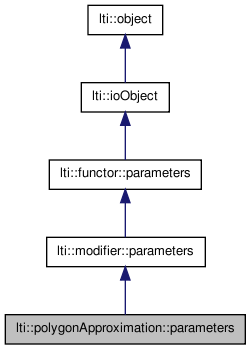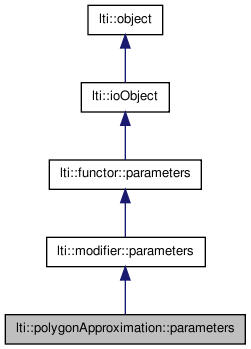

|
latest version v1.9 - last update 10 Apr 2010 |
|
the parameters for the class polygonApproximation More...
#include <ltiPolygonApproximation.h>


Public Member Functions | |
| parameters () | |
| parameters (const parameters &other) | |
| ~parameters () | |
| const char * | getTypeName () const |
| parameters & | copy (const parameters &other) |
| parameters & | operator= (const parameters &other) |
| virtual functor::parameters * | clone () const |
| virtual bool | write (ioHandler &handler, const bool complete=true) const |
| virtual bool | read (ioHandler &handler, const bool complete=true) |
Public Attributes | |
| int | minStep |
| bool | searchMaxDistance |
| double | maxDistance |
| bool | closed |
the parameters for the class polygonApproximation
| lti::polygonApproximation::parameters::parameters | ( | ) |
default constructor
Reimplemented from lti::modifier::parameters.
| lti::polygonApproximation::parameters::parameters | ( | const parameters & | other | ) |
copy constructor
| other | the parameters object to be copied |
Reimplemented from lti::modifier::parameters.
| lti::polygonApproximation::parameters::~parameters | ( | ) | [virtual] |
destructor
Reimplemented from lti::functor::parameters.
| virtual functor::parameters* lti::polygonApproximation::parameters::clone | ( | ) | const [virtual] |
returns a pointer to a clone of the parameters
Reimplemented from lti::modifier::parameters.
| parameters& lti::polygonApproximation::parameters::copy | ( | const parameters & | other | ) |
copy the contents of a parameters object
| other | the parameters object to be copied |
Reimplemented from lti::modifier::parameters.
| const char* lti::polygonApproximation::parameters::getTypeName | ( | ) | const [virtual] |
returns name of this type
Reimplemented from lti::modifier::parameters.
| parameters& lti::polygonApproximation::parameters::operator= | ( | const parameters & | other | ) |
copy the contents of a parameters object
| other | the parameters object to be copied |
| virtual bool lti::polygonApproximation::parameters::read | ( | ioHandler & | handler, | |
| const bool | complete = true | |||
| ) | [virtual] |
read the parameters from the given ioHandler
| handler | the ioHandler to be used | |
| complete | if true (the default) the enclosing begin/end will be also written, otherwise only the data block will be written. |
Reimplemented from lti::modifier::parameters.
| virtual bool lti::polygonApproximation::parameters::write | ( | ioHandler & | handler, | |
| const bool | complete = true | |||
| ) | const [virtual] |
write the parameters in the given ioHandler
| handler | the ioHandler to be used | |
| complete | if true (the default) the enclosing begin/end will be also written, otherwise only the data block will be written. |
Reimplemented from lti::modifier::parameters.
If true, only the found vertices will be in the list.
If false, the last point of the list will be adjacent to the first point in the list.
Default: true
Specify the maximal allowed euclidean distance between the border points and the approximated polygon.
(if negative, each "minStep" pixel of the border points will be taken).
Default value: 1
Minimal "distance" between vertices of the polygon.
if 0 or negative, only the maxDistance parameter will be considered). The "distance" used here is NOT the euclidean distance between the vertices but the number of elements between both vertices in the border list. These is usually therefore a city-block distance or an 8-neighborhood distance depending on the border-points description used.
Default value: -1 (i.e. use only maxDistance).
If true, the first two vertices will be computed as the two points in the border with the maximal distance.
If false, the first point in the list will be a vertex and the border point with the maximal distance to it too. This faster method is the default. It provides usually good results.
Default value: false